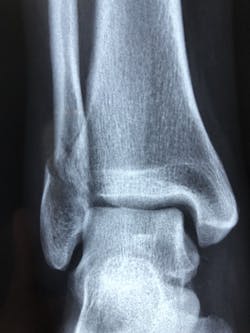The U.S. Food and Drug Administration (FDA) approved the Patient Specific Talus Spacer 3D-printed talus implant for humanitarian use. The Patient Specific Talus Spacer is the first-in-the-world and first-of-its-kind implant to replace the talus – the bone in the ankle joint that connects the leg and the foot, according to a news release from the agency.
The approval is for the use of the device specifically for the treatment of avascular necrosis (AVN) of the ankle joint, a serious and progressive condition that causes the death of bone tissue stemming from a lack of blood supply to the area. The implant provides a joint-sparing alternative to other surgical interventions commonly used in late-stage AVN that may disable motion of the ankle joint.
AVN is often caused by a sudden injury – such as a broken bone or a dislocated joint – or sustained damage to the tissue that develops over time, and it occurs when there is a lack of blood supply to bone tissue, causing it to become necrotic, meaning it dies. When the bones of a joint are affected, such as in the case of the ankle, the cartilage that keeps the bones from rubbing together can deteriorate, causing arthritis and pain. Late-stage AVN of the ankle may result in the talus bone partially or fully collapsing. Current available treatments include fusing the joints in the foot and ankle together—a procedure which helps to alleviate pain caused by AVN but eliminates motion in the joint—or below-the-knee amputation.
The Patient Specific Talus Spacer is a 3D printed implant that can be used in talus replacement surgery. The talus spacer is made for each patient individually, modeled from computed tomography (CT) imaging, and is fitted to a patient’s specific anatomy. During the replacement surgery, the patient’s talus bone is removed and replaced with the implant, which is made from cobalt chromium alloy.
While fusion may become necessary in the future should the condition worsen, talus replacement surgery with the Patient Specific Talus Spacer is intended to be a joint-sparing procedure, as it allows the patient to retain motion in the ankle joint.
The FDA reviewed data for the Patient Specific Talus Spacer through the humanitarian device exemption (HDE) process. A Humanitarian Use Device (HUD) is a device that is intended to benefit patients by treating or diagnosing a disease or condition that affects not more than 8,000 individuals in the U.S. per year.
The FDA granted the HDE approval of the Patient Specific Talus Spacer to Additive Orthopaedics, LLC.

